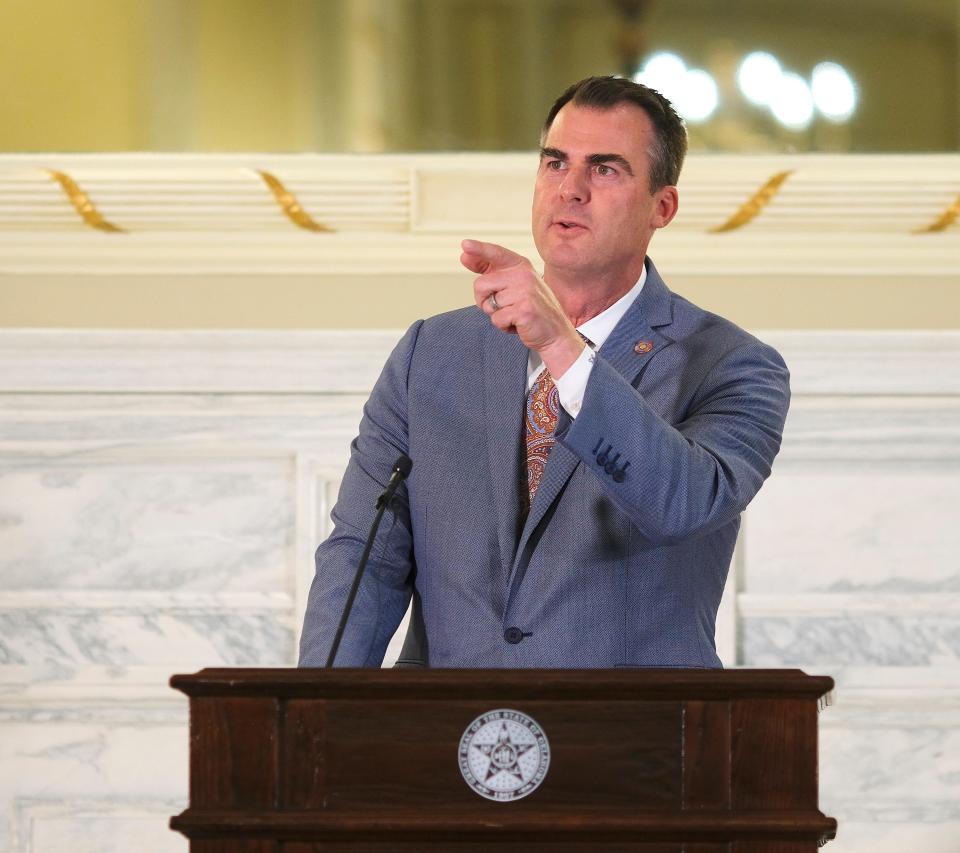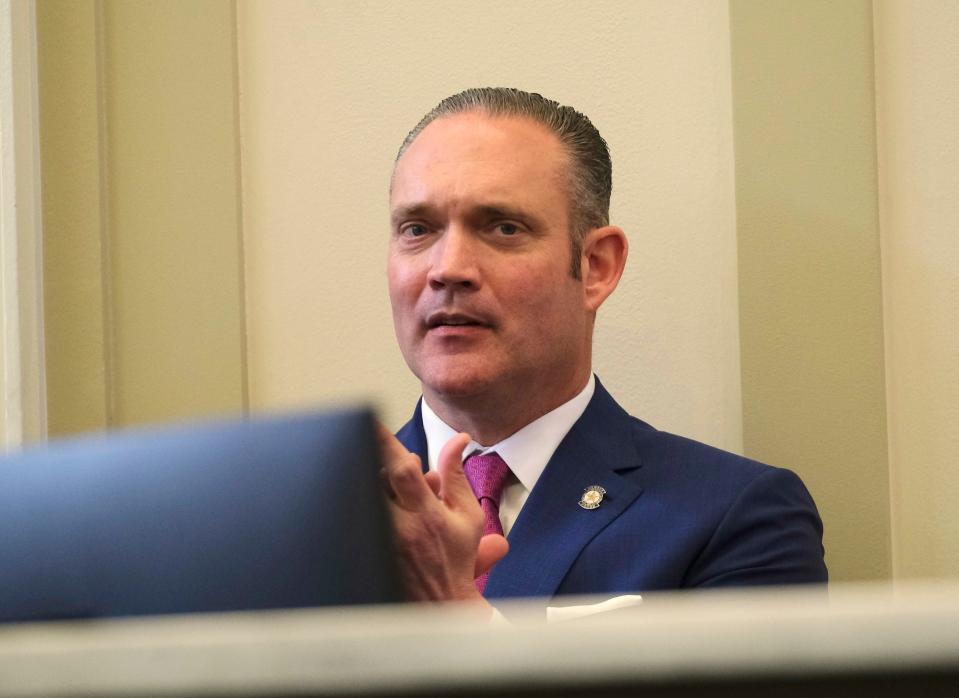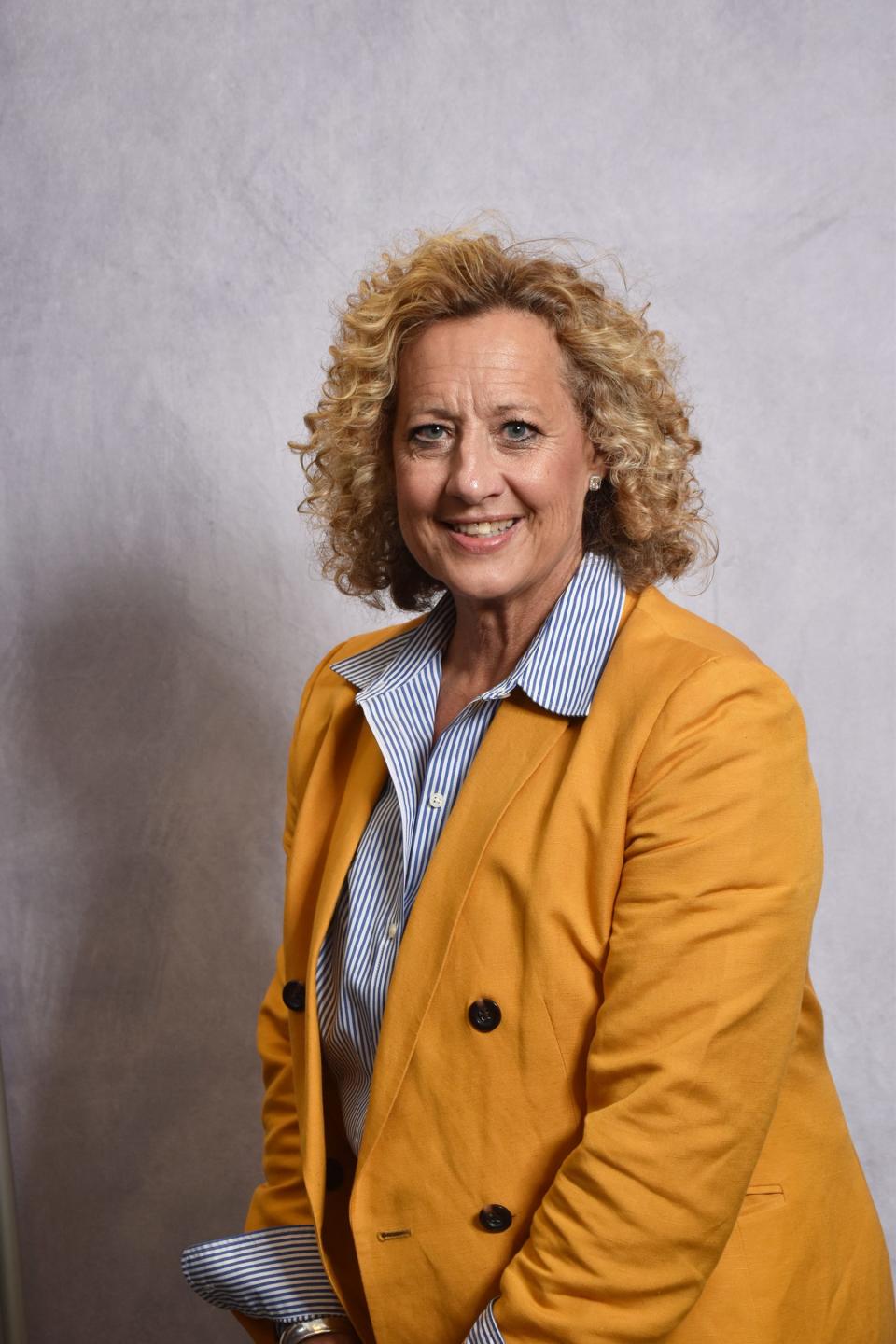With record $2.8 billion in Oklahoma's savings accounts, state leaders resist calls to spend
- Oops!Something went wrong.Please try again later.
Oklahoma has a record $2.8 billion in state savings accounts, but state leaders say they intend to keep that money socked away for a rainy day.
Gov. Kevin Stitt and Republican legislative leaders have no plans to dip into state savings anytime soon, even though some are calling for using a portion of the funds to cover emergency needs or help Oklahoma families amid high inflation.
The state's savings have grown in large part due to Gov. Kevin Stitt. On the campaign trail in 2018, he vowed to grow the accounts to at least $2 billion by the end of his first term so Oklahoma could have a financial cushion should the state's economic picture worsen.
Before Stitt was elected, the last record high for state savings was $597 million in fiscal year 2008, according to figures from the Office of Management and Enterprise Services. When Stitt took office, the state had $452 million in savings, said OMES spokesman Caden Cleveland.

Stitt said he doesn't envision using any savings unless the state experiences an economic downturn.
"It's like in your own budget, you have a little nest egg that you set aside for emergencies and downturns, etc.," Stitt said in a recent interview.
New Oklahoma laws: Stricter anti-abortion rules, marijuana business moratorium take effect
Citing savings, Stitt reiterates call for tax cuts
In light of new record high savings, Stitt is renewing his call for the Oklahoma Legislature to cut taxes to offset high inflation.
It's unclear if the governor and both chambers of the Legislature will be able to come to an agreement on inflation relief this year. Although the House passed a series of tax cut bills in a June special session, Senate leaders panned the lower chamber's approach and opted to study tax reform instead.
"Now is the time that we can lower taxes a little bit because we don't need to keep piling on the savings account," Stitt said.
The governor is pushing for a 0.25% cut to all personal income tax rates and either the elimination or a suspension of the state's 4.5% sales tax on groceries. He does not want to eliminate local grocery taxes, which are crucial to funding municipal governments.
A Senate working group on tax reform has had seven or eight productive meetings over the summer, said Senate Pro Tem Greg Treat, R-Oklahoma City.
"We're still having discussions within the Senate on tax reform," Treat said. "Not just tax cuts, per se, but what is the best tax policy for Oklahoma to grow our economy and to make sure it's equitable?"
Citing inflation and the state's teacher shortage, Democratic gubernatorial candidate and state schools Superintendent Joy Hofmeister said now is the time to dip into state savings to cover some emergency needs.
"To tout that he's sitting on cash at a time when people in Oklahoma are struggling is just not good leadership," she said. Stitt's office highlighted the record savings in a news release this month, attributing the growth in state reserves to "conservative fiscal discipline."
In March, Hofmeister advocated for suspending the state's gas tax while prices at the pump were rising.
Hofmeister said she would take a "balanced" approach to state savings. She said she would advocate for spending some of the funds to help offset the state's teacher shortage or provide inflation relief, but some money should remain socked away in case of volatility in the oil and natural gas markets.
The state budget is heavily dependent on revenue from oil and gas production taxes.
Hofmeister said cutting personal income taxes is inadvisable right now because that would reduce the amount of funding available for education and other state services.
"We have a long list of unmet needs in our state," she said. "We cannot further reduce the very elements of state government that build a robust economy and attract business to our state or keep people here."
How far will state savings go?
As of June, there was just over $1 billion in Oklahoma's Rainy Day Fund.
That's enough to fund state government for 58 days, a new record high for Oklahoma, said Justin Theal, a research officer at The Pew Charitable Trusts. Oklahoma's spending power is greater than the 50-state median of 42 days, he said.
When Oklahoma's economy is thriving, up to 15% of the General Revenue Fund estimate for the preceding year is automatically diverted to the Rainy Day Fund. In the event of a budget shortfall, lawmakers can only use three-eighths of the funds.
The fiscal year that concluded June 30 was the first year Oklahoma made the maximum contribution to the Rainy Day Fund since voters raised the cap from 10% to 15% in 2010, said Cleveland, of OMES.
When factoring in all of Oklahoma's reserves, the state has enough funding to operate government for 165 days, said Theal, who works on Pew's state fiscal policy team.
There's no one-size-fits-all rule for how much much states should save, he said.
"States with significant economic or revenue volatility may want to have larger financial cushions to help hedge against those year-to-year fluctuations," Theal said. "That's why you see states that derive large amounts of their tax revenue from the energy industry tend to have higher amounts set aside to help offset the unpredictability that comes with that type of income."
When policymakers craft plans for how to build up reserves and set conditions for when those funds could be spent, states are better prepared to weather a budget crunch, he said.
Story continues below podcast.
House leader doesn't want history to repeat itself
There's no target number for how much House Speaker Charles McCall wants to see in state savings, but there is a figure that is top of mind when he thinks about the state's previous budget deficits.
From 2015-2018, Oklahoma experienced $2.7 billion in budget shortfalls that left lawmakers scrambling for cash to fund the government.
A banker, McCall, R-Atoka, estimates if Oklahoma had $3.7 billion in savings during those years, the state could have avoided any budget deficits and prevented cuts at state agencies.

But that figure comes with a caveat. Roughly $3.7 billion in savings would have prevented agency cuts when the state had a $6 billion budget, McCall said. Now, the state budget is close to $10 billion.
Lawmakers tapped into savings in 2020 when the state faced a revenue failure at the beginning of the COVID-19 pandemic after the economic uncertainty of the global health crisis tanked oil prices.
"You have to have reserves in order to not go back to the days when the state of Oklahoma was operating day-to-day, trying to find the money to do the things that it needed to do for the people of the state," McCall said.
There's no question that Oklahoma will experience another economic downturn, McCall said, noting there is talk at the national level of a recession on the horizon.
Knowing Oklahoma has significant savings also gives the state more options and flexibility with the rest of its funds, he said.
Without those reserves, lawmakers might not have felt comfortable setting aside $698 million in cash to offer economic development incentives for Project Ocean, McCall said.
"We've got more opportunities, we have greater certainty and stability because we have strong state reserves," McCall said. "If Project Ocean doesn't materialize, that money is stacked on top of our state savings. ... We'll be at over $3 billion with that, which is not a bad place to be."
Project Ocean is the state's codename for efforts to entice Panasonic to build an electric vehicle battery plant in Oklahoma. Although, Panasonic previously announced it would locate a battery plant in Kansas, state leaders have suggested Oklahoma is not out of the running yet because a second factory could be in the works.
If the multibillion-dollar company locates in Oklahoma, that could mean thousands of new, high-paying jobs, which will lead to more tax revenue, McCall said.
State should spend to attract, retain teachers, teachers union says
After the announcement in Kansas, legislative Democrats and public education advocates called on legislative leaders to repurpose some of that $698 million.
Although many legislative Democrats supported legislation to create the economic development incentive for Panasonic, some members of the minority party now want that money to be used to offset tax cuts or increase funding for state services.
Democratic lawmakers for years have argued the majority party was socking away too much in state savings instead of devoting more funding to education and other services.

In light of the record state savings, Oklahoma Education Association President Katherine Bishop renewed calls for state leaders to spend some of the economic development funds to attract and retain teachers and K-12 support staff.
She praised the Legislature for approving this year a new incentive program to shore up the teacher pipeline. But the program will take years to get more teachers in the classroom, Bishop said.
The state has had a shortage of qualified teachers for years, but now there's money to do something about it, she said. "We have never been in a position where we have had more revenue into our state, in our reserves, in our Rainy Day (Fund), and we're not touching it at all to address a crisis that we're having," Bishop said.
This article originally appeared on Oklahoman: Oklahoma state leaders reject calls to spend record $2.8B in savings

